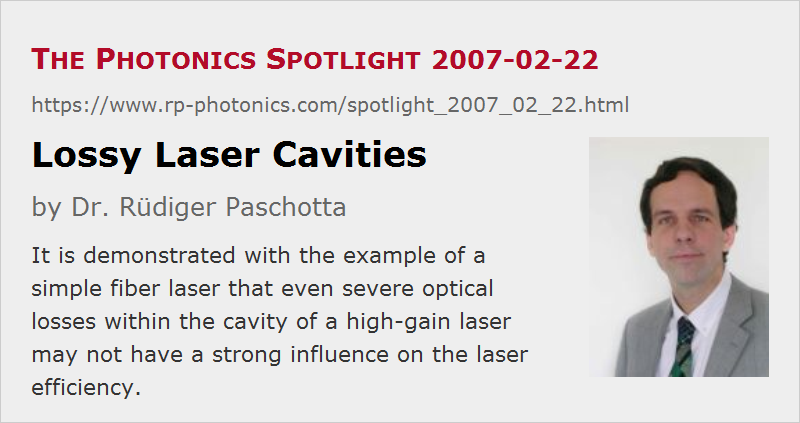Lossy Laser Cavities
Posted on 2007-02-22 as a part of the Photonics Spotlight (available as e-mail newsletter!)
Permanent link: https://www.rp-photonics.com/spotlight_2007_02_22.html
Author: Dr. Rüdiger Paschotta, RP Photonics Consulting GmbH
Abstract: It is demonstrated with the example of a simple fiber laser that even severe optical losses within the cavity of a high-gain laser may not have a strong influence on the laser efficiency.

Ref.: encyclopedia articles on output coupling efficiency, wall-plug efficiency
What kind of efficiency would you expect from a laser where you have 50% parasitic losses for the light circulating in the laser resonator? Probably not a very good one, right?
Well, things are not necessarily that bad in such a case. Imagine a simple fiber laser, where the output coupler is just a bare (and perpendicularly cleaved) fiber end, providing some 4% reflection, while the other end of the rare-earth doped fiber has a reflector with 50% losses. Assuming no other parasitic losses, the round-trip gain under steady-state lasing conditions must be ≈17 dB, so the single-pass gain is 8.5 dB. Compared with the power hitting the output coupling end, the power hitting the lossy reflector end is down by some (14 - 17/2) dB = 5.5 dB, and half of that power is lost. So for every watt hitting the output coupling end, we get 0.96 W coupled out and 0.14 W lost at the other end. The resulting output coupling efficiency is 87% – actually not that bad!
The key conclusion is that the importance of intracavity losses for the power efficiency (see also: wall-plug efficiency) strongly depends on the available laser gain, which determines how high the output coupler transmission can be.
As an interesting detail, note that 50% losses for the circulating light do not necessarily mean that 50% of all generated light power is lost. In a high-gain laser resonator, the 50% loss may apply to some power which is far lower than that hitting the output coupler mirror.
These aspects are important for high-gain lasers, such as many fiber lasers: these can be very tolerant to intracavity losses. On the other hand, one then often also requires quite massive influences e.g. to achieve wavelength tuning, single-frequency operation, or mode locking.
This article is a posting of the Photonics Spotlight, authored by Dr. Rüdiger Paschotta. You may link to this page and cite it, because its location is permanent. See also the RP Photonics Encyclopedia.
Note that you can also receive the articles in the form of a newsletter or with an RSS feed.
Questions and Comments from Users
Here you can submit questions and comments. As far as they get accepted by the author, they will appear above this paragraph together with the author’s answer. The author will decide on acceptance based on certain criteria. Essentially, the issue must be of sufficiently broad interest.
Please do not enter personal data here; we would otherwise delete it soon. (See also our privacy declaration.) If you wish to receive personal feedback or consultancy from the author, please contact him e.g. via e-mail.
By submitting the information, you give your consent to the potential publication of your inputs on our website according to our rules. (If you later retract your consent, we will delete those inputs.) As your inputs are first reviewed by the author, they may be published with some delay.
 |



If you like this page, please share the link with your friends and colleagues, e.g. via social media:
These sharing buttons are implemented in a privacy-friendly way!